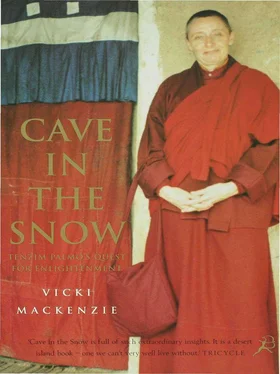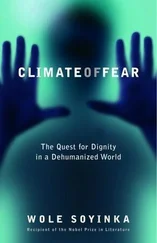There were other attractions. Fortuitously, considering her quest to attain enlightenment as a women, she had landed in the midst of a vortex of female spiritual energy. On the summit of the mountain opposite was a curious black rock called by the locals ’The Lady of Keylong’. Even in the midst of winter the shape remained inexplicably free of snow. On closer inspection one could make out the silhouette of a kneeling woman draped in a mantle with a baby at her breast and one hand outstretched feeding a small bird. To the Western eye it bore an uncanny resemblance to the Madonna and child, although to the Lahoulis she was Tara, the female Buddha of Compassion. High on a precipice nearby could be found a faded blue and gold painting of the same goddess. It had apparently appeared there spontaneously several centuries earlier, having moved itself from the opposite side of the valley, its form still clearly visible to the perceptive eye. And down the way, not far from the cave, was a spot said to be inhabited by the powerful Buddhist protectress Palden Lhamo, traditionally depicted riding on a mule. One day several years later Tenzin Palmo was to see footprints of a mule embedded in the snow at this very spot. Strangely there were no other footprints leading to or from it.
All in all it was perfect. Here she could finally devote her entire energy and time to profound and prolonged meditation. She could begin to unravel the secrets of the inner world – the world that was said to contain the vastness and the wonder of the entire universe.
If she was happy at her discovery of the cave, her companions were not. They proceeded to throw at her all the objections and discouragements that had been hurled at women who wanted to engage in serious meditation in total isolation down the ages. Tenzin Palmo deftly fielded each one.
‘It’s too high! Nobody, let alone a woman, can survive at this altitude. You will die,’ they chorused.
‘But caves are warmer than houses. They are thermostatically controlled. My house in Tayul is freezing in winter and I survive that. This cave will be better,’ she replied.
‘Well, living so far away from any living person you will be a sitting duck for thieves who will break in and rob you,’ they retorted.
’There are no thieves in Lahoul. You can see for yourself how the Lahouli women walk around wearing all their jewellery quite openly and no one tries to rob them,’ she argued.
‘Men from the army camp will come up and rape you,’ they tried again.
‘By the time they have climbed this high they will be so exhausted all they will want is a cup of tea,’ she responded.
‘What about the ghosts? These places are haunted, don’t you know? You will be terrified,’ they continued.
At this point Tenzin Palmo’s Tibetan failed her. Believing they were talking about snakes instead of ghosts (the word being similar in Tibetan), she blithely replied, ‘Oh I don’t mind them at all.’ This nonchalant declaration impressed her detractors almost to silence, but not quite.
‘Well, we’re not going to help you move up here because if we do we will only be aiding you in your own death. And we are not going to be party to that.’ They were adamant.
‘If I get permission from my guru, Khamtrul Rinpoche, will you agree and help?’ she asked. They finally nodded their heads.A letter was duly dispatched to Tashi Jong, and after asking her several searching questions about the position and condition of the cave Khamtrul Rinpoche gave his permission. The objections were at last quelled.
In that one brief argument Tenzin Palmo overturned centuries of tradition, which decreed that women were not capable of doing extensive retreats in totally isolated places in order to advance themselves to higher spiritual levels. In doing so she also became the first Western woman to follow in the footsteps of the Eastern yogis of old and enter a Himalayan cave to seek Enlightenment.
Before she could begin her great work, however, the cave had to be made habitable. With the help from her Lahouli friends she employed labourers to brick up the front and side of the cave with walls made especially thick to keep out the ferocious cold. A small area inside was partitioned off to use as a storeroom for her supplies of food. It was essential, but reduced her living space still further, to a minuscule area of six feet wide by six feet deep. The floor also had to be scooped out to give her room to stand up, then baked earth was put on top of it, then flagstones, then more earth. They put in a window and a door, which Tshering Dorje insisted open inwards – an insight which was to prove invaluable in the drama that was to follow. Then they slapped mud and cow-dung on the floor and walls. After that they levelled off the ledge outside, making it into a patio where Tenzin Palmo could sit and bask in that breathtaking view. Finally they constructed a stone wall around the perimeter of the cave to keep the wild animals at bay and to establish a boundary for her retreat area.
Into the cave Tenzin Palmo put her furniture: a small wood-burning stove (a legacy of the Moravian missionaries who had once tried to convert the Lahoulis) with a flue pipe that thrust out of the front wall; a wooden box for a table covered with a flowery tablecloth; a bucket. On the walls she hung pictures of Buddhist deities in their various manifestations.A handy depression in the wall became her bookshelf holding her precious dharma texts, carefully wrapped in yellow cloth to keep the loose pages together, bookbinding never having made it to Tibet. On a natural ledge she placed her ritual implements of dorje and bell, the mystic thunderbolt signifying compassion, the bell Emptiness or wisdom. These were the two ‘wings’ of Tibetan Buddhism which, when realized, were said to fly you all the way to Enlightenment. And against the back wall was her altar, holding the images of her personal meditational deities, a miniature stupa (representing the Buddha Mind) and a text (representing the dharma). In front of this she set up seven small offering bowls which she filled with water. They represented the seven gifts offered to any distinguished visitor who graced your house with his or her presence: water for drinking, water for washing the feet, flowers, food, perfume, light and music.
And then there was the most unusual object of all, a traditional meditation box. This was a square wooden structure measuring 2ft 6in by 2ft 6in and raised slightly off the ground to insulate the meditator from rising damp. It was where she would spend the greater part of her life. Over the years she developed a remarkably close attachment to it: ‘I loved my meditation box. I’d wrap myself in my cloak and be perfectly snug there, out of the way of draughts,’ she said enthusiastically.
When it was finished the gaping, jagged hole in the mountain had been transformed into a pretty little house with a crooked rocky roof, so quaint it could have come out of the pages of a fairytale book. It instantly dispelled any notion of cliched cave-living.
‘It was a very pukka cave,’ Tenzin Palmo admitted. ‘The few people who saw it were always very surprised how neat and cosy it was. It was small, certainly. There was no room to dance! Although when I did my long retreat I did do Hatha yoga there. Yoga was great in counteracting all the sitting I did and in helping with the problems with my spine,’ she said, referring to the back problems which had plagued her since birth. ‘But the cave was so small I had to do different postures in different parts of the cave, depending on where there was room.’
Didi Contractor was one person who witnessed the cave. A large, grey-haired woman now in her late sixties, she had come to India from California many decades earlier and had led a colourful life in an extended family with her Indian husband. She had met Tenzin Palmo during one of her visits to Khamtrul Rinpoche and had stayed in touch. As an interior designer (responsible for such famous landmarks as the Lake Palace in Udaipur), she wanted to throw a professional eye over Tenzin Palmo’s unorthodox living arrangements to make sure she was safe: ’The climb up was horrific, especially over the loose scree. I looked down on the tiny houses in the valley below and thought, “If I fall I’m strawberry jam.” Tenzin Palmo, who escorted me, however, bounded up like an antelope. When I finally got there I was reassured. The cave was very secure and safe. The walls were thick - although I did arrange for her to have double glazing put on the windows. Most importantly, it was south-facing, which meant it got the sun for the whole day which was essential in winter. My God, it was tiny though. There was just room for me to lay my sleeping bag down beside her meditation box. That was it,’ she said, from the mud-brick house which she had built herself just below Dharamsala, home of the Dalai Lama and his government in exile.
Читать дальше












